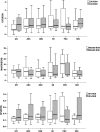A Study on Gene Expression Profile of Endogenous Antioxidant Enzymes: CAT, MnSOD and GPx in Dengue Patients
- PMID: 29062175
- PMCID: PMC5634981
- DOI: 10.1007/s12291-017-0633-x
A Study on Gene Expression Profile of Endogenous Antioxidant Enzymes: CAT, MnSOD and GPx in Dengue Patients
Abstract
Dengue is an arthropod-borne threat among tropical countries. Currently no effective means to treat the virus or to predict which patient will develop the severe form of the disease. Recently the relationship between oxidative/antioxidative response and dengue pathogenesis was suggested. Based on this the present study has analysed the expression of endogenous antioxidant genes: Catalase (CAT), Superoxide dismutase (MnSOD) and Glutathione peroxidase in patients with dengue compared to other febrile illness (OFI) and healthy controls. The study enrolled 88 dengue confirmed patients comprising 56 were patients with non-severe dengue, and 32 were severe dengue cases, 31 were patients with OFI, and 63 healthy controls were also involved. Peripheral blood mononuclear cells isolated from patients and controls during the day of admission and from the available cases on the day of defervescence were used to estimate the transcript levels by quantitative PCR. The expression levels of all the three genes were found to be down-regulated throughout the course of dengue infection (p < 0.05) and OFI cases compared to healthy controls. Within dengue group, no significant difference was observed in any of the parameters between severe and non-severe cases. Interestingly, a significant down-regulation of MnSOD expression was recorded in secondary dengue infection compared to primary during admission (p < 0.05). It was found that all the down-regulated study genes have positively correlated in all dengue cases during the day of admission (p < 0.01). But during defervescence, the same was found only between CAT and MnSOD. Down-regulated endogenous antioxidant enzymes during dengue infection could be the possible rationale of oxidative stress reported in dengue disease earlier. The present study markers could not distinguish dengue from OFI cases and severe from non-severe dengue cases. Mechanism of down-regulation has to be explored further which will pave the way for the therapeutic target in dengue disease.
Keywords: CAT; Dengue; GPx; MnSOD.
Figures


References
-
- WHO|Global Strategy for dengue prevention and control, 2012–2020 [Internet]. WHO. [cited 2016 Mar 22]. Available from: http://www.who.int/denguecontrol/9789241504034/en/.
LinkOut - more resources
Full Text Sources
Other Literature Sources
Miscellaneous
